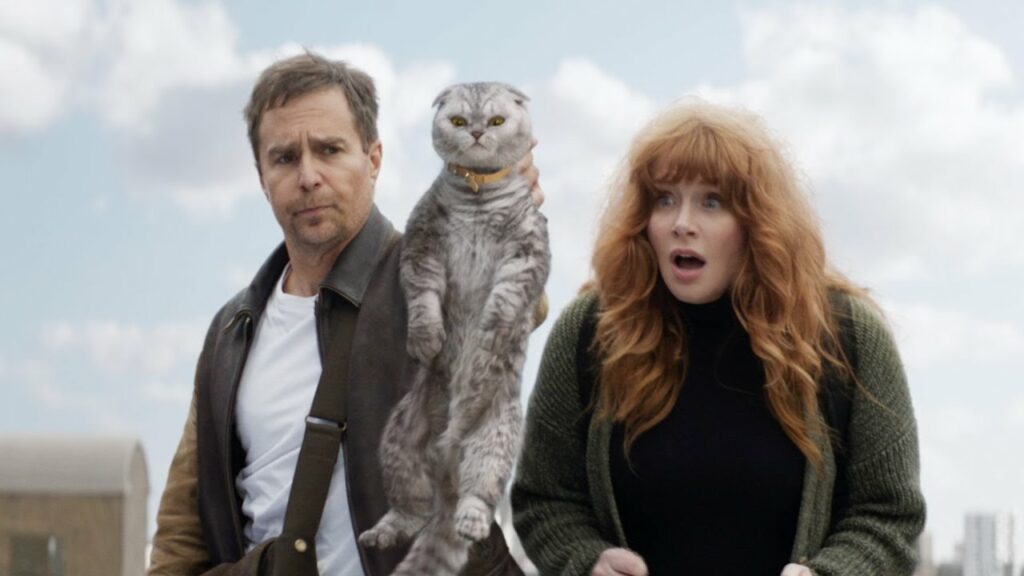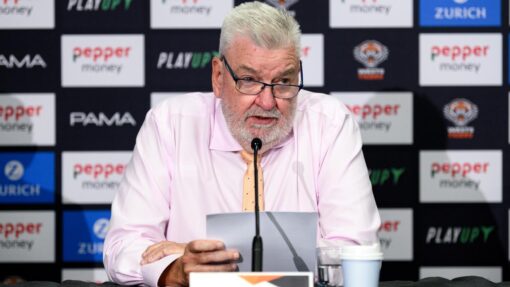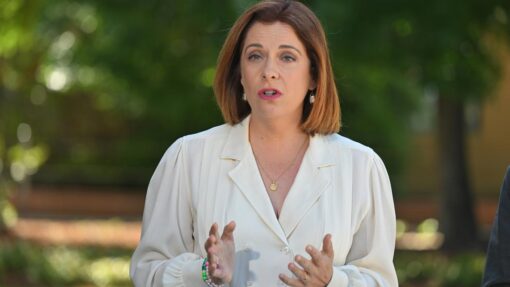Review: Argylle

Screen reviews by Christopher Gist
Q:Why does the film feel slow?
A: The story hasn’t started yet.
Q: When does the story start?
In Argylle, kinda sorta not until someone tells us that our heroine’s spy novels “predict” the future, and that she’s going to get killed because of it. But even that isn’t really what’s going on. Like the marketing strategy for this film, it’s complicated.
Written by Jason Fuchs (co-writer, Ice Age: Continental Drift) and directed by Matthew Vaughn (Kingsman), Argylle is an explosion of colour, featuring comedy riffs on James Bond action sequences, a cat in a funny porthole backpack, and a Romancing the Stone-like heroine caught up in things much bigger than her.
Nice-girl Elly Conway (Bryce Dallas Howard), has her reclusive, successful, writer’s life upended when scruffy Aidan Wilde (Sam Rockwell) insists on sitting opposite her on a train. Elly takes trains because she’s afraid of flying. In fact, she’s afraid of lots of things. Prior to this we’ve spent a bit of time watching her write at home, and Zoom with her mum/mom, and now we’re spending a bit of time with her with Aidan as he natters to her as the train journeys along, prior to him revealing that he’s a spy. This marks the commencement of the film’s second action sequence, a fun fight on the train, cartoonish in its scale, with its winks and nudges. It also features a curious, although ultimately, plot-related, intercutting of Aidan as the real spy with Agent Argylle (Henry Caville), Elly’s fantasy spy from her novel.
We have already seen Agent Argylle at the start of the film in a cartoonish Bond-like opener which has Argylle in a Moke smashing his way across Grecian rooftops to capture the sexy evil Legrange (Dua Lipa). From the train fight on, the film juggles Sam Rockwell and Henry Cavill as the agent involved in the action, intercutting them as the hero agent during fight sequences and plot postulations, while Elly watches these events unfold in front of her and tries to make sense of them.
So, with all this action and intrigue, what’s not working?
For a start, Hollywood-style screen stories typically begin when the hero’s/heroine’s goal is established and the opposition rises to block that goal. If you’re watching something and bored, this may be one of the reasons – the story hasn’t properly kicked off. In Argylle, Elly is passive for quite some time in a story where many things are not what they seem. She has a general goal in that she wants to stay alive, but not the usual, specific visible goal of a Hollywood lead character. Added to this is that the film is a caper in which many of the characters around Elly are in imposture. This creates a distance between us and them as genuine characters, and makes it harder to connect emotionally with them. On top of these double stories, Elly’s journey piles on a third layer as the story endeavours to keep the twists and turns coming.
Other questions arise for the audience, such as why it’s taken the bad guys so long to want to whack Elly – after all, she’s written four break-out novels and is onto her fifth. Why not stop her after the first secret-revealing novel became a best-seller?
These hurdles to understanding and connection are exacerbated by Elly not reacting in the way many of us would to the many crises that afflict her. I won’t spoil the secrets but, suffice to say, when Elly is forced to cross some very tough emotional terrain, not once does she ask a question relevant to the killings she has just witnessed. As my wife exclaimed: “Who is this person?” Certainly, we are in a heightened reality where Sam Rockwell can burst up through floorboards like Superman but, irrespective of who Elly ultimately is, she is introduced to us as a normal-ish person, and we are asked to have the normal range of sympathies for her for a long stretch of her story. While we can laugh at cartoons, it’s less often that we cry for them.
The talent attached to this project is enormous: Catherine O’Hara, Bryan Cranston, Samuel L. Jackson, Adriana DeBose, and John Cena. Cena seems under-used but maybe there are bigger plans for him in a sequel. Scotland features beyond the argyle: music is by Scotsman Lorne Balfe (Mission Impossible, The Lego Batman Movie, Terminator Genisys), and the oft-deployed cat is a Scottish Fold. The production values are first rate, and both the “ice-skating on oil” fight and rainbow-coloured smoke bomb fight aboard a massive oil tanker are so lavish that it made me wonder if those visuals were design starting points for Vaughn.
Reputedly, all this cost around USD$200 million – on its way to about a third of a billion Aussie dollars at around $312 million. It has so far taken around USD$95 million at the box office, according to Box Office Mojo. To put the price into context for our local industry, Screen Australia’s total feature production spend for 2022/23 was on 17 titles and reported at $12.7 million. So Argylle cost around 24.5 times our federal agency’s production spend on Australian films for a year.
I enjoyed Vaughn’s Kingsman films which this film references in things such as the elegant armoury with its countless interior-designer arranged weapons, but the many negative reviews stopped us from blowing 70 or 80 bucks at the cinema on a Saturday night. Argylle has the hallmarks of things we’d normally enjoy, but the spectacle overtook the emotional engagement for us. If you’re still keen, the good news is you can see it at no extra cost if you are an Apple TV subscriber.
Q: Why has Argylle got two Ls in it?
A: Because it rhymes with R Kylle (if you can avoid pronouncing it kill), itself a little Easter Egg plot reveal.
* For those interested in the marketing tie-in book with its own layers of publicity-generating misdirection (did Taylor Swift write the novel? – she, too, has a Scottish Fold cat), it was written by Terry Hayes and Tammy Cohen. Details are here.



